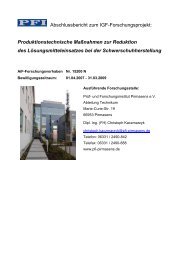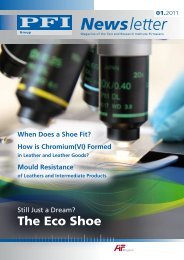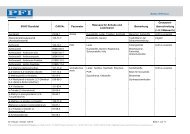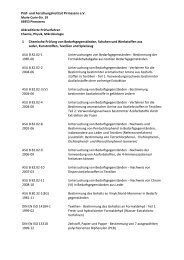Newsletter - PFI Germany Start
Newsletter - PFI Germany Start
Newsletter - PFI Germany Start
Create successful ePaper yourself
Turn your PDF publications into a flip-book with our unique Google optimized e-Paper software.
46<br />
<strong>Newsletter</strong> CHEMISTRY<br />
Contact Allergies Caused by Footwear?<br />
Hunt for Allergens<br />
The frequency with which footwear manufacturers<br />
and retailers approach <strong>PFI</strong> with requests for help<br />
because consumers blame footwear as the cause of<br />
itching feet and blisters is steadily increasing. In some<br />
cases customers even submit allergy ID cards showing<br />
that their treating physician has been able to identify<br />
an allergenic substance. A subsequent laboratory<br />
search for the allergen in the article under suspicion<br />
is like looking for a needle in a haystack. Why is this<br />
so and what makes identifi cation of the substance responsible<br />
for the allergic reaction so very diffi cult?<br />
Some 30 to 40 percent of the population of <strong>Germany</strong><br />
is affected by at least one allergy.<br />
Prevalence of allergies in the population<br />
30 % Respiratory tract allergies<br />
10 % Drug allergies<br />
5 to 7 % Food allergies<br />
7 % Contact allergies<br />
2 to 3 % Insect sting allergies<br />
An allergy is an exaggerated response of the immune<br />
system. Its principal task is to recognise environmental<br />
toxins, irritants, and foreign organisms – such as<br />
bacteria – and to effectively protect us against them.<br />
It is constantly monitoring the entire organism and is<br />
on the lookout for “intruders”. Anything the immune<br />
system regards as “foreign” will initially be classed as<br />
an “intruder”. This will not always be a harmful substance<br />
in the sense of a toxin. It may be a “perfectly<br />
normal” food ingredient or fragrance.<br />
The immune system is particularly active at those parts<br />
of the organisms most likely to come into contact<br />
with the environment, such as the skin, mucous membranes,<br />
or the gastrointestinal tract. It ensures that<br />
the “intruders” can do no damage. This non-specifi c<br />
protective mechanism normally proceeds completely<br />
unnoticed and without any bodily reaction.<br />
What Causes an Allergy and When Is<br />
an “Intruder” an “Allergen”?<br />
If the burden placed on the human body by intruders<br />
is extreme and the situation possibly compounded by<br />
physical or psychological stress, the immune system is<br />
compelled to mobilise additional forces to counter the<br />
attack. This “reinforcement” can offer a signifi cantly<br />
greater defence potential. The effects can manifest<br />
themselves as reddening of the skin, infl ammation, or<br />
tissue damage. If the immune system overreacts in this<br />
way, the intruder triggering the reaction is designated<br />
as an “allergen”.<br />
Once the immune system has combatted a given “allergen”<br />
it “memorises” precisely that allergen in order<br />
to react rapidly on renewed contact (immunity). This<br />
process is also described as sensitisation. Renewed contact<br />
with the allergen can then trigger a very powerful<br />
defence reaction. Allergic immunity is thus primarily<br />
a defence mechanism against intruders lurking in the<br />
environment.<br />
In the case of a “massive attack” by allergens the defence<br />
reactions can even give rise to damage. <strong>Start</strong>ing<br />
with reddening via hive formation and itching all the<br />
way to respiratory distress or circulatory complaints,<br />
in extreme cases the result may be a<br />
so-called anaphylactic shock, possibly<br />
even with fatal consequences.
















